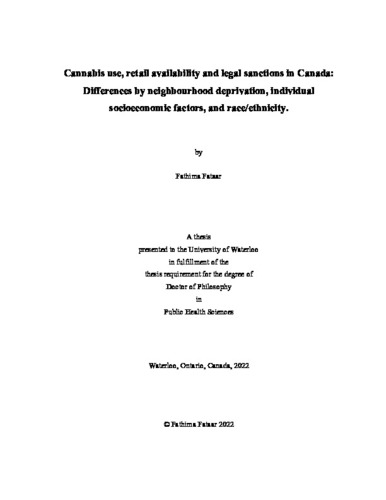| dc.description.abstract | Background: Cannabis legalization in Canada represents one of the most significant changes in substance use policy over the past century. One of the primary objectives of cannabis legalization is to reduce illicit trade and the disproportionate negative impact of criminalization on racialized individuals and those with lower socioeconomic position. The extent to which legalization of non-medical cannabis redresses these disparities has yet to be assessed. In particular, there is little evidence on the impact of different regulatory policies, such as the distribution of legal retail outlets, as well as community-level factors such as neighbourhood deprivation.
Objectives: This dissertation examined three primary research questions: 1) Are there differences in cannabis-related legal sanctions based on race/ethnicity, individual socioeconomic factors and neighbourhood deprivation?; 2) Are there differences in problematic cannabis use pre- and post-cannabis legalization based on race/ethnicity, individual socioeconomic factors and neighbourhood deprivation?; and 3) What is the distribution of legal cannabis retail stores based on neighbourhood deprivation?
Methods: Studies 1 and 2 used repeat cross-sectional data from wave 2 and 3 and waves 1-3, respectively, of the International Cannabis Policy Study (ICPS). Wave 1 was conducted prior to cannabis legalization from August-October 2018, and Wave 2 and Wave 3 data were collected post-legalization in September-October 2019 and 2020, respectively. The ICPS is a web-based survey conducted annually in Canada among those aged 16 to 65. Respondents were recruited using non-probability sampling methods through the Nielsen Consumer Insights Global Panel and their partners’ panels. Individual respondent postal code data was linked to the Institut National de Santé Publique du Québec (INSPQ) 2016 material and social deprivation index to obtain a measure of neighbourhood material and social deprivation for each participant. In Study 1, multinomial regression models were used to examine the associations between individual-level socioeconomic indicators, race/ethnicity and neighbourhood deprivation and arrests and convictions for cannabis-related criminal offences. Similarly, in Study 2, multinomial regression models were used to examine the associations between individual-level socioeconomic indicators, race/ethnicity and neighbourhood deprivation and problematic cannabis use using the World Health Organization Alcohol, Smoking and Substance Use Screening Test (ASSIST) measure. In addition, interaction terms between survey year and predictor variables were included to examine pre- and post-legalization changes in problematic use.
In Study 3, data on physical cannabis retail outlet locations including postal code were collected from government websites which included all available locations up to September 2021. Postal code data was linked to the INSPQ 2016 material and social deprivation index. Descriptive statistics were used to characterize the distribution of stores by neighbourhood material and social deprivation in Canada overall and within each of the provinces and territories.
Results:
Study 1: Overall, 4.4% of respondents reported a lifetime arrest or conviction for a cannabis-related offence. Compared to respondents who identified as White, Black and Indigenous individuals had more than 3 times the odds of conviction (AOR=3.90 95%CI=2.07-7.35, p<0.01; AOR=3.24 95% CI=1.78-5.90, p<0.01, respectively). Differences remained after adjusting for cannabis use and socioeconomic factors however only the difference for Black individuals remained after adjusting for neighbourhood deprivation. Neighbourhood deprivation was associated with cannabis-related convictions: the odds of a conviction among the ‘most privileged’ and ‘privileged’ neighbourhoods were approximately half of those in the ‘most deprived’ neighbourhoods (AOR=0.50, 95%CI=0.29-0.86; p=0.01; AOR=0.50, 95% CI=0.27-0.92; p=0.03, respectively).
Study 2: There was little evidence in support of changes in ‘high risk’ problematic cannabis use among past 12-month cannabis consumers from before cannabis legalization (2018=5.7%) to 12- or 24-months after legalization (2019=4.5%, 2020=5.0%, all p>0.10). There was a decrease in ‘moderate risk’ between 2018-2019 (p=0.03) and between 2018 and 2020 (p=0.01). Problematic use differed by sociodemographic factors. For example, compared to those from more materially deprived neighbourhoods the odds of ‘moderate risk’ vs ‘low risk’ were lower for consumers from neighbourhoods which were ‘neither deprived nor privileged’ (AOR=0.78, 95%CI=0.64-0.95; p=0.01); ‘privileged’ (AOR 0.60, 95%CI=0.49-0.7, p<0.01); and ‘most privileged’ (AOR=0.70; 95%CI=0.57-0.86, p=0.01). However, there were few differences in ‘high risk’. Black, Middle Eastern and South Asian individuals were more likely than White individuals to experience ‘high risk’ compared to ‘low risk’ (AOR=2.63, 95%CI=1.33-5.22, p=0.01; AOR=4.22, 95%CI=1.93-9.19, p<0.01; AOR=2.33, 95%CI=1.14-4.78, p=0.02, respectively). Differences across subgroups were consistent from 2018 to 2020.
Study 3: At the national level, there were approximately 8.0 retail cannabis stores per 100,000 individuals age 15+ as of September 2021. The distribution of stores was closely aligned with the expected distribution across levels of material deprivation: for example, 19.5% of stores were located in neighbourhoods with the lowest level of material deprivation versus 19.1% in the highest level. More cannabis stores were located in the ‘most socially deprived’ or ‘socially deprived’ neighbourhoods (37.2% and 22.1%, respectively), characterized by a higher proportion of residents who live alone, are unmarried, or in single-parent families. The distribution of stores in provinces and territories were generally consistent with national patterns with a few exceptions.
Conclusions: Cannabis legalization in Canada has presented the opportunity to redress some of the harms associated with cannabis use, particularly for racialized individuals and those in lower socioeconomic position. Lifetime arrests and conviction for cannabis-related offences were disproportionately higher among racialized people, especially Black and Indigenous people, as well as those with lower socioeconomic position and those living in more deprived neighbourhoods. While the current work suggests few differences in problematic cannabis use in the early stages of legalization, the findings also highlight the greater burden of problematic use on racialized and marginalized people. However, the relatively even distribution of retail stores at all levels of material neighbourhood deprivation is encouraging. Continued monitoring will be needed to determine if this continues in the rapidly evolving legal cannabis retail market to ensure that those in more materially deprived neighbourhoods are not disproportionately impacted. Going forward guidelines and policies to minimize harms associated with cannabis use and increase inclusion in the legal cannabis industry for racialized and marginalized people are needed. | en |

